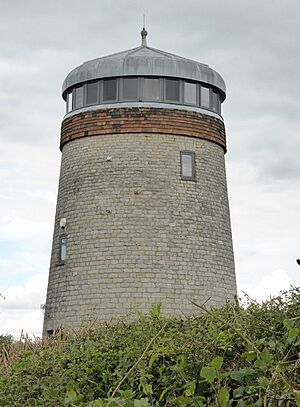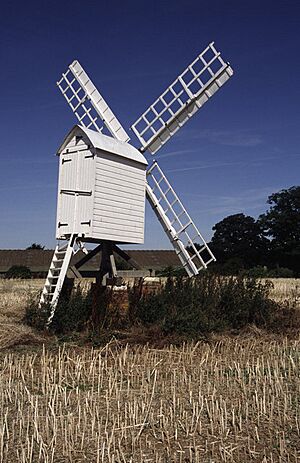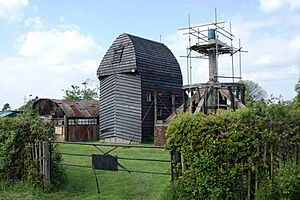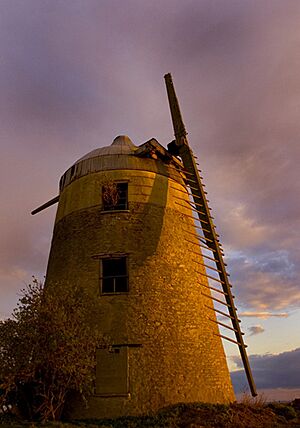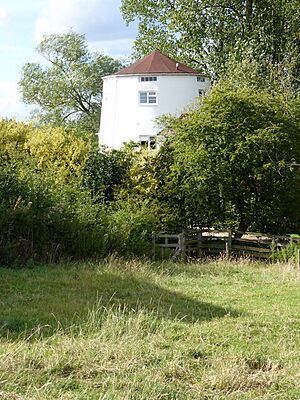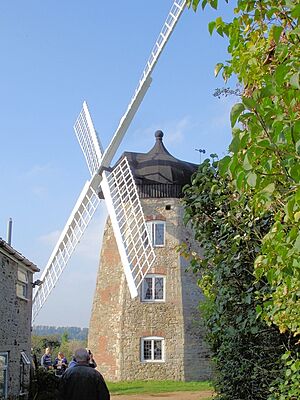List of windmills in Oxfordshire facts for kids
Have you ever seen a windmill? These amazing structures use the power of the wind to do work, usually grinding grain into flour. For hundreds of years, windmills were super important for communities, helping to make food. This page lists some of the windmills that have existed in Oxfordshire, a county in England.
Windmills come in different shapes and sizes. The most common types you'll hear about are:
- Post mills: These are the oldest type. The whole body of the mill, which holds the machinery and sails, can turn on a large central post to face the wind.
- Tower mills: These mills have a tall, fixed tower, usually made of stone or brick. Only the cap (the top part with the sails) turns to catch the wind.
- Smock mills: Similar to tower mills, but their towers are made of wood and shaped like a smock (a type of old shirt), wider at the bottom and narrower at the top.
Contents
Famous Windmills in Oxfordshire
Oxfordshire has been home to many windmills over the centuries. Some are still standing, while others are just memories. Here are a few notable ones:
Blackthorn East Mill
The East Mill in Blackthorn is a tower mill. It was built in the 18th century, which means sometime in the 1700s. This mill is still standing and is a great example of how these old structures can last for a long time. It's a reminder of how people used wind power in the past.
Bloxham Grove Windmill
The Bloxham Grove Mill in Bloxham is a post mill. It was built in 1865. This type of mill is special because the entire top part, including the sails, can be rotated to face the wind. This mill is also still standing, showing us a piece of history from the mid-1800s.
Chinnor Windmill
There have been a few windmills in Chinnor. One was known as early as 1249! The Chinnor Mill you can see today is a post mill that was rebuilt in 2009. This shows that even old types of mills can be brought back to life. The original mill on this site was built in 1789 and was taken apart in 1965.
Milton Common Mill, Great Haseley
The Milton Common Mill is a tower mill located in Great Hasely. It was built around 1760. Tower mills are strong and sturdy, often made of stone. This mill is another example of an old windmill that has survived to this day, giving us a glimpse into the past.
North Leigh Mill
The North Leigh Mill is a tower mill from the 18th century, found in North Leigh. Like other tower mills, only its cap and sails would turn to catch the wind. This mill is still standing and is a significant historical landmark in the area.
Wardington Windmill
In Wardington, you can find the Wardington Mill, which is a tower mill. It was first mentioned in 1715, meaning it's been around for a very long time! This mill is still standing and is a great example of the long history of windmills in Oxfordshire.
Wheatley Windmill
The Wheatley Windmill in Wheatley is a tower mill that was built in 1784. This mill has a rich history and is now looked after by the Wheatley Windmill Restoration Society. It's a fantastic place to visit to learn more about how windmills work and what they were used for.
Other Notable Windmills (Past and Present)
Many other windmills have played a part in Oxfordshire's history. Some are no longer standing, but their locations are still known.
- Middleton Road Mill, Bicester: This mill in Bicester was blown down in 1881. It was a sad day when this old mill was destroyed by strong winds.
- Nettlebed Mill: This smock mill in Nettlebed was built in 1825 but sadly burned down in 1912. Smock mills were often made of wood, which made them vulnerable to fire.
- Arncott Mill: A post mill in Arncott that collapsed in 1950.
- Great Milton Mill: A post mill in Great Milton that was taken down in 1910.
- South Weston Mill: This smock mill was built in 1676 and taken down in 1919.
Maps and Records
Historians and researchers use old maps and documents to find out where windmills once stood and when they were active. Some important maps that show windmills in Oxfordshire include:
- 1675 Ogilby map
- 1715 Overton map
- 1794 Richard Davis map
- 1823 Bryant map
These maps help us understand how important windmills were across the county in different periods of history.


